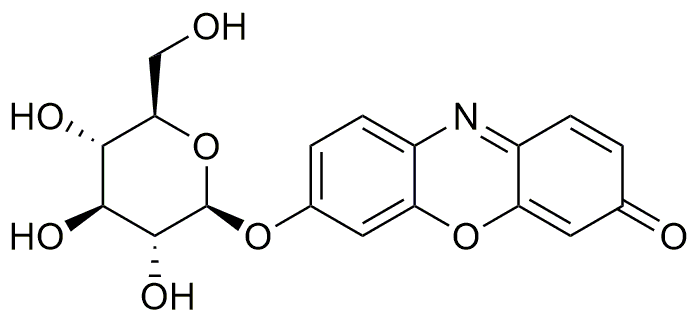Resorufin b-D-glucopyranoside is widely utilized in research focused on:
- Biochemical Assays: This compound serves as a fluorescent substrate in various enzymatic assays, particularly for measuring the activity of β-glucosidases. Its fluorescence allows for sensitive detection, making it valuable in both academic and industrial laboratories.
- Cell Viability Studies: It is used in cell culture experiments to assess cell health and proliferation. The conversion of resorufin from its non-fluorescent precursor provides a straightforward method for evaluating cytotoxicity and cell viability.
- Drug Discovery: In pharmaceutical research, it aids in screening for potential drug candidates by evaluating their effects on specific enzymes. This application is crucial for identifying compounds that can modulate biological pathways effectively.
- Environmental Monitoring: The compound can be employed in assays to detect glucosidase activity in environmental samples, helping researchers monitor soil health and microbial activity, which is essential for ecological studies.
- Diagnostic Applications: Resorufin b-D-glucopyranoside has potential uses in clinical diagnostics, particularly in tests that require the detection of specific enzyme activities related to various diseases, enhancing the accuracy of diagnostic procedures.
General Information
Properties
Safety and Regulations
Applications
Resorufin b-D-glucopyranoside is widely utilized in research focused on:
- Biochemical Assays: This compound serves as a fluorescent substrate in various enzymatic assays, particularly for measuring the activity of β-glucosidases. Its fluorescence allows for sensitive detection, making it valuable in both academic and industrial laboratories.
- Cell Viability Studies: It is used in cell culture experiments to assess cell health and proliferation. The conversion of resorufin from its non-fluorescent precursor provides a straightforward method for evaluating cytotoxicity and cell viability.
- Drug Discovery: In pharmaceutical research, it aids in screening for potential drug candidates by evaluating their effects on specific enzymes. This application is crucial for identifying compounds that can modulate biological pathways effectively.
- Environmental Monitoring: The compound can be employed in assays to detect glucosidase activity in environmental samples, helping researchers monitor soil health and microbial activity, which is essential for ecological studies.
- Diagnostic Applications: Resorufin b-D-glucopyranoside has potential uses in clinical diagnostics, particularly in tests that require the detection of specific enzyme activities related to various diseases, enhancing the accuracy of diagnostic procedures.
Documents
Safety Data Sheets (SDS)
The SDS provides comprehensive safety information on handling, storage, and disposal of the product.
Product Specification (PS)
The PS provides a comprehensive breakdown of the product’s properties, including chemical composition, physical state, purity, and storage requirements. It also details acceptable quality ranges and the product's intended applications.
Certificates of Analysis (COA)
Search for Certificates of Analysis (COA) by entering the products Lot Number. Lot and Batch Numbers can be found on a product’s label following the words ‘Lot’ or ‘Batch’.
*Catalog Number
*Lot Number
Certificates Of Origin (COO)
This COO confirms the country where the product was manufactured, and also details the materials and components used in it and whether it is derived from natural, synthetic, or other specific sources. This certificate may be required for customs, trade, and regulatory compliance.
*Catalog Number
*Lot Number
Safety Data Sheets (SDS)
The SDS provides comprehensive safety information on handling, storage, and disposal of the product.
DownloadProduct Specification (PS)
The PS provides a comprehensive breakdown of the product’s properties, including chemical composition, physical state, purity, and storage requirements. It also details acceptable quality ranges and the product's intended applications.
DownloadCertificates of Analysis (COA)
Search for Certificates of Analysis (COA) by entering the products Lot Number. Lot and Batch Numbers can be found on a product’s label following the words ‘Lot’ or ‘Batch’.
*Catalog Number
*Lot Number
Certificates Of Origin (COO)
This COO confirms the country where the product was manufactured, and also details the materials and components used in it and whether it is derived from natural, synthetic, or other specific sources. This certificate may be required for customs, trade, and regulatory compliance.


